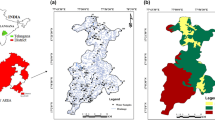Abstract
Groundwater quality samples from 33 wells were collected in the lower Ketar watershed (Ethiopia) to study its suitability for domestic and irrigation purposes. Samples were evaluated for major ions and physicochemical properties. In 58% of the samples analyzed, Ca2+ is the dominant cation and Na+ dominates the remaining 42% of the samples. Among the anions found during analyzation, HCO3− is the solo dominant ion in all the wells sampled. The order of the concentration of the major ions was Ca2+ > Na+ > Mg2+ > K+ for the cations and HCO3− > SO42− > Cl > NO3− for the anions. AquaChem analysis shows that Ca–HCO3 and Na–HCO3 are the major water types in the area. The analyses indicated that the dissolution of fluorite or fluorapatite is the possible source of the high fluoride concentration in the area. And, the interactions between water and rock and cation exchanges mainly determine the water quality. The suitability of the groundwater for use in irrigation was evaluated based on the salinity (EC), SAR, %Na, RSC, PI, KR, and the USSL Salinity diagram. The groundwater from most of the wells can be used for irrigation without any significant restriction except for a few of the wells downstream. Its suitability for domestic use was evaluated by comparing with the WHO standard limits. The parameters limiting the use of this groundwater for drinking purposes are F− (94%), HCO3− (45%), and Ca2+ (33%). All the remaining major cations and anions complied with the WHO standard limits for drinking.








Similar content being viewed by others
Explore related subjects
Discover the latest articles and news from researchers in related subjects, suggested using machine learning.References
Abbate, E., Bruni, P., & Sagri, M. (2015). Geology of Ethiopia: A Review and Geomorphological Perspectives. In P. Billi (Ed.), Landscapes and Landforms of Ethiopia (pp. 33–64). Dordrecht: Springer Netherlands. doi:10.1007/978–94–017–8026–1_2
Allison, L. E., Brown, J. W., Hayward, H. E., Richards, A., Bernstein, L., Fireman, M., et al. (1954). United States Salinity Laboratory Staff, 166.
An, Y., & Lu, W. (2018). Hydrogeochemical processes identification and groundwater pollution causes analysis in the northern Ordos Cretaceous Basin China. Environmental Geochemistry and Health,40(4), 1209–1219. https://doi.org/10.1007/s10653-017-0037-0.
Appelo, C. A. J., & Postma, D. (2005). Geochemistry, groundwater and pollution (2nd ed.). Boca Raton, London, New York: CRC Press, Taylor & Francis Group.
Ayenew, T. (2001). Numerical Groundwater Flow Modeling of the Central Main Ethiopian Rift Lakes Basin, 24(2), 167–184
Ayers, R. S., & Westcot, D. W. (1985). Water quality for agriculture. Rome: Food and Agriculture Organization of the United Nations.
Ayotte, J. D., Szabo, Z., Focazio, M. J., & Eberts, S. M. (2011). Effects of human-induced alteration of groundwater flow on concentrations of naturally-occurring trace elements at water-supply wells. Applied Geochemistry,26(5), 747–762. https://doi.org/10.1016/j.apgeochem.2011.01.033.
Bartram, J., Ballance, R., United Nations, & World Health Organization (Eds.). (1996). Water quality monitoring: a practical guide to the design and implementation of freshwater quality studies and monitoring programmes (1st ed.). London, New York: E & FN Spon.
Bauder, T. A., Waskom, R. M., Davis, J. G., & Sutherland, P. L. (2011). Irrigation water quality criteria. Colorado State University Extension Fort Collins, CO. https://extension.colostate.edu/docs/pubs/crops/00506.pdf. Accessed 3 June 2017.
Bemer, E. K., & Bemer, R. A. (1987). Water, Air, and Geochemical Cycles (2nd ed.). Princeton and Oxford: Princeton University Press.
Clescerl, L. S., Greenberg, A. E., & Eaton, A. D. (1999). Standard Methods for Examination of Water & Wastewater (20th ed., Vol. 19). American Public Health Association (APHA), American Water Works Association (AWWA), and Water Environment Federation (WEF).
Cloutier, V., Lefebvre, R., Savard, M. M., Bourque, É., & Therrien, R. (2006). Hydrogeochemistry and groundwater origin of the Basses-Laurentides sedimentary rock aquifer system, St. Lawrence Lowlands, Québec, Canada. Hydrogeology Journal, 14(4), 573–590. doi:10.1007/s10040–005–0002–3
European Commission. (2007). Common implementation strategy for the water framework directive (2000/Guidance on groundwater monitoring. Luxenbourg: Office for Official Publications of the European Communities.
Di Paola, G. M. (1972). The Ethiopian Rift Valley (Between 7° Off and 8° 40’ lat. North), 44.
Doneen, L. D. (1964). Water Quality for Agriculture (p. 48). Department of Irrigation: University of California, Davies.
Eaton, F. M. (1950). Significance of Carbonates in Irrigation Waters. Soil Science,69(2), 123–134.
Eberts, S. M., & George, L. L. (2000). Regional ground-water flow and geochemistry in the Midwestern basins and arches aquifer system in parts of Indiana, Ohio, Michigan, and Illinois: Sandra M. Eberts and Lori L. George. Reston, VA: Denver, CO: U.S. Dept. of the Interior, U.S. Geological Survey, For sale by the U.S. Geological Survey, Branch of Information Services.
Fetter, C. W. (2001). Applied Hydrogeology (Fourth Edition.). Pearson Education.
Gorelick, S. M., & Zheng, C. (2015). Global change and the groundwater management challenge: Groundwater Management Challenge. Water Resources Research,51(5), 3031–3051. https://doi.org/10.1002/2014WR016825.
Green, T. R. (2016). Linking Climate Change and Groundwater. In A. J. Jakeman, O. Barreteau, R. J. Hunt, J.-D. Rinaudo, & A. Ross (Eds.), Integrated Groundwater Management (pp. 97–141). Cham: Springer International Publishing. doi:10.1007/978–3–319–23576–9_5
Güler, C., Thyne, G. D., McCray, J. E., & Turner, K. A. (2002). Evaluation of graphical and multivariate statistical methods for classification of water chemistry data. Hydrogeology Journal,10(4), 455–474. https://doi.org/10.1007/s10040-002-0196-6.
Harter, T. (2003). Groundwater Quality and Groundwater Pollution. University of California, Agriculture and Natural Resources.. https://doi.org/10.3733/ucanr.8084.
Hem, J. D. (1991). Study and Interpretation of the Chemical Characteristics of Natural Water (Third.). United States Government Printing Office.
Hutchison, W., Pyle, D. M., Mather, T. A., Yirgu, G., Biggs, J., Cohen, B. E., et al. (2016). The eruptive history and magmatic evolution of Aluto volcano: new insights into silicic peralkaline volcanism in the Ethiopian rift. Journal of Volcanology and Geothermal Research,328, 9–33. https://doi.org/10.1016/j.jvolgeores.2016.09.010.
Waterloo Hydrogeologic. (2015). AquaChem Readme. https://www.novametrixgm.com/aquachem-readme. Accessed 8 September 2016
Johnston, D., South Australia, & Environment Protection Authority (2002). (2007). Regulatory monitoring and testing: groundwater sampling. Adelaide: Environment Protection Authority.
Kaiser, H. F. (1974). An index of factorial simplicity. Psychometrika,39(1), 31–36. https://doi.org/10.1007/BF02291575.
Karmegam, U., Chidambaram, S., Prasanna, M. V., Sasidhar, P., Manikandan, S., Johnsonbabu, G., et al. (2011). A study on the mixing proportion in groundwater samples by using Piper diagram and Phreeqc model. Chinese Journal of Geochemistry,30(4), 490–495. https://doi.org/10.1007/s11631-011-0533-3.
Kebede, S., Travi, Y., Asrat, A., Alemayehu, T., Ayenew, T., & Tessema, Z. (2008). Groundwater origin and flow along selected transects in Ethiopian rift volcanic aquifers. Hydrogeology Journal,16(1), 55–73. https://doi.org/10.1007/s10040-007-0210-0.
Kelley, W. P. (1963). Use of Saline Irrigation Water. Soil Science,95(6), 385–391.
Kloos, H., & Haimanot, R. T. (1999). Distribution of fluoride and fluorosis in Ethiopia and prospects for control. Tropical Medicine & International Health,4(5), 355–364. https://doi.org/10.1046/j.1365-3156.1999.00405.x.
Langmuir, D. (1997). Aqueous environmental geochemistry. Upper Saddle River, N.J: Prentice Hall.
Li, P., Qian, H., Wu, J., & Ding, J. (2010). Geochemical modeling of groundwater in southern plain area of Pengyang County, Ningxia China. Water Science and Engineering,3(3), 282–291.
Li, X., Wu, H., Qian, H., & Gao, Y. (2018). Groundwater Chemistry Regulated by Hydrochemical Processes and Geological Structures: A Case Study in Tongchuan China. Water,10(3), 338. https://doi.org/10.3390/w10030338.
Lutz, A., Thomas, J. M., & Keita, M. (2010). Effects of Population Growth and Climate Variability on Sustainable Groundwater in Mali West Africa. Sustainability,3(1), 21–34. https://doi.org/10.3390/su3010021.
Madhnure, P., Peddi, N. R., & Allani, D. R. (2016). An integrated hydrogeological study to support sustainable development and management of groundwater resources: a case study from the Precambrian Crystalline Province India. Hydrogeology Journal,24(2), 475–487. https://doi.org/10.1007/s10040-015-1342-2.
Milovanovic, M. (2007). Water quality assessment and determination of pollution sources along the Axios/Vardar River Southeastern Europe. Desalination,213(1–3), 159–173. https://doi.org/10.1016/j.desal.2006.06.022.
Mousazadeh, H., Mahmudy-Gharaie, M. H., Mosaedi, A., & Moussavi Harami, R. (2018). Hydrochemical assessment of surface and ground waters used for drinking and irrigation in Kardeh Dam Basin (NE Iran). Environmental Geochemistry and Health. https://doi.org/10.1007/s10653-018-0214-9.
Parkhurst, D. L., & Appelo, C. A. J. (2013). Description of input and examples for PHREEQC version 3—A computer program for speciation, batch-reaction, one-dimensional transport, and inverse geochemical calculations (Vol. book 6). https://pubs.usgs.gov/tm/06/a43/.
Peng, C., He, J.-T., Wang, M., Zhang, Z., & Wang, L. (2018). Identifying and assessing human activity impacts on groundwater quality through hydrogeochemical anomalies and NO3 −, NH4 +, and COD contamination: a case study of the Liujiang River Basin, Hebei Province, P.R. China. Environmental Science and Pollution Research, 25(4), 3539–3556. doi:10.1007/s11356–017–0497-x
Piper, A. M. (1944). A graphic procedure in the geochemical interpretation of water-analyses. Eos, Transactions American Geophysical Union,25(6), 914–928. https://doi.org/10.1029/TR025i006p00914.
Qin, R., Wu, Y., Xu, Z., Xie, D., & Zhang, C. (2013). Assessing the impact of natural and anthropogenic activities on groundwater quality in coastal alluvial aquifers of the lower Liaohe River Plain, NE China. Applied Geochemistry,31, 142–158. https://doi.org/10.1016/j.apgeochem.2013.01.001.
Raj, D., & Shaji, E. (2017). Fluoride contamination in groundwater resources of Alleppey, southern India. Geoscience Frontiers,8(1), 117–124. https://doi.org/10.1016/j.gsf.2016.01.002.
Rango, T., Bianchini, G., Beccaluva, L., Ayenew, T., & Colombani, N. (2009). Hydrogeochemical study in the Main Ethiopian Rift: new insights to the source and enrichment mechanism of fluoride. Environmental Geology,58(1), 109–118. https://doi.org/10.1007/s00254-008-1498-3.
Rango, T., Bianchini, G., Beccaluva, L., & Tassinari, R. (2010). Geochemistry and water quality assessment of central Main Ethiopian Rift natural waters with emphasis on source and occurrence of fluoride and arsenic. Journal of African Earth Sciences,57(5), 479–491. https://doi.org/10.1016/j.jafrearsci.2009.12.005.
Reardon, E. J., & Wang, Y. (2000). A limestone reactor for fluoride removal from wastewaters. Environmental Science & Technology, 34(15), 3247–3253.
Richards L.A (Ed.). (1954). Diagnosis and Improvement of Saline and Alkaline Soils. U. S. Government Printing Office Washington 25, D. C.
Sdiri, A., & Higashi, T. (2013). Simultaneous removal of heavy metals from aqueous solution by natural limestones. Applied Water Science,3(1), 29–39. https://doi.org/10.1007/s13201-012-0054-1.
Sheng, Z. (2013). Impacts of groundwater pumping and climate variability on groundwater availability in the Rio Grande Basin. Ecosphere, 4(1), art5. doi:10.1890/ES12–00270.1
Todd, D. K., & Mays, L. W. (2005). Groundwater Hydrology. John Wiley & Sons, Inc.
Tolera, M. B., Park, S., Chang, S. W., & Chung, I.-M. (2017). Spatial assessment of groundwater quality in the Jangseong region, South Korea. Environmental Earth Sciences, 76(15). doi:10.1007/s12665–017–6875–3
WHO. (2007). Combating waterborne disease at the household level: the international network to promote household water treatment and safe storage. Geneva: World Health Organization.
Winter, T. C., Mallory, S. E., Allen, T. R., & Rosenberry, D. O. (2000). The Use of Principal Component Analysis for Interpreting Ground Water Hydrographs. Ground Water,38(2), 234–246. https://doi.org/10.1111/j.1745-6584.2000.tb00335.x.
WHO. (2004). Guidelines for drinking-water quality. World Health Organization.
WHO. (2011). Guidelines for drinking-water quality. World Health Organization.
WWDR. (2015). Water for a Sustainable World. France: The United Nations Educational, Scientific and Cultural Organization.
Acknowledgments
The data collection and laboratory analysis were supported by a research grant from the Adama Science and Technology University (Ethiopia). The remaining work was funded by the Korea Ministry of Environment (MOE) as Demand Responsive Water Supply Service Program (146515) and Basic Research Project (19‐3411) of the Korea Institute of Geoscience and Mineral Resources (KIGAM) funded by the Ministry of Science and ICT.
Author information
Authors and Affiliations
Corresponding author
Additional information
Publisher's Note
Springer Nature remains neutral with regard to jurisdictional claims in published maps and institutional affiliations.
Rights and permissions
About this article
Cite this article
Tolera, M.B., Choi, H., Chang, S.W. et al. Groundwater quality evaluation for different uses in the lower Ketar Watershed, Ethiopia. Environ Geochem Health 42, 3059–3078 (2020). https://doi.org/10.1007/s10653-019-00508-y
Received:
Accepted:
Published:
Issue Date:
DOI: https://doi.org/10.1007/s10653-019-00508-y
Keywords
Profiles
- Il-Moon Chung View author profile





